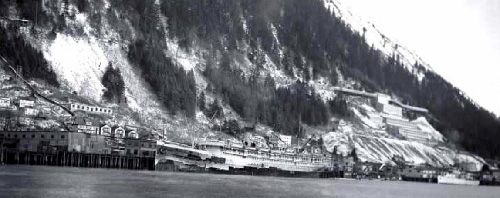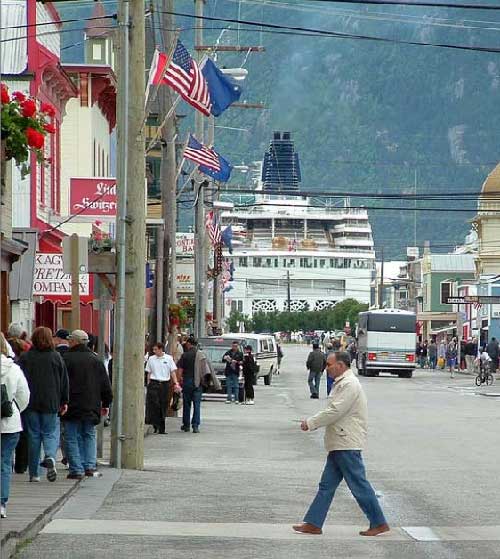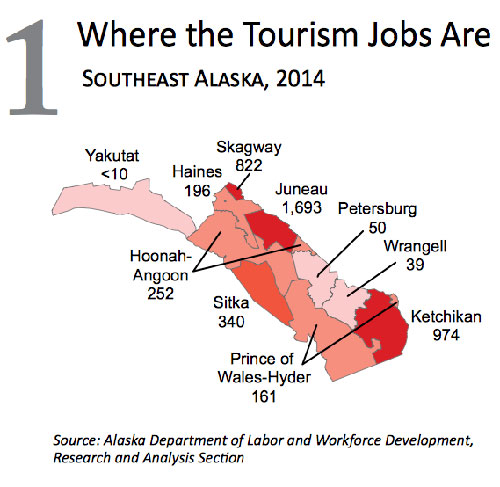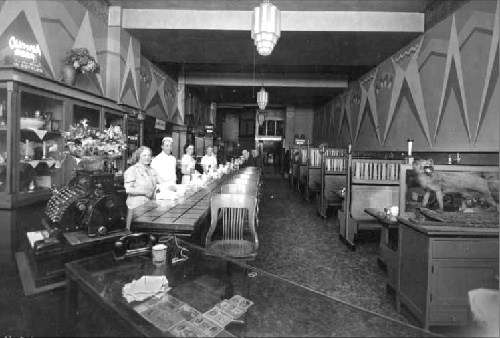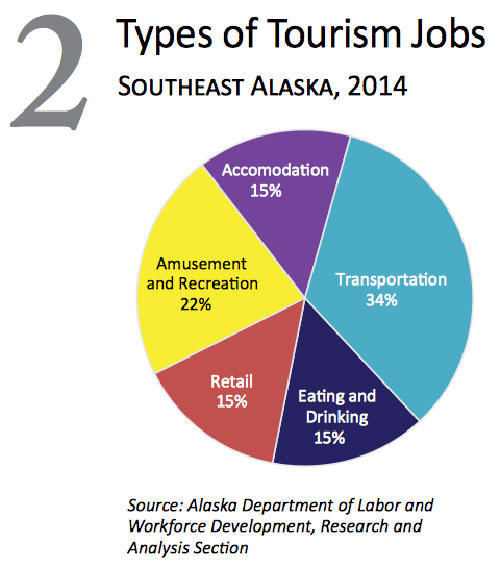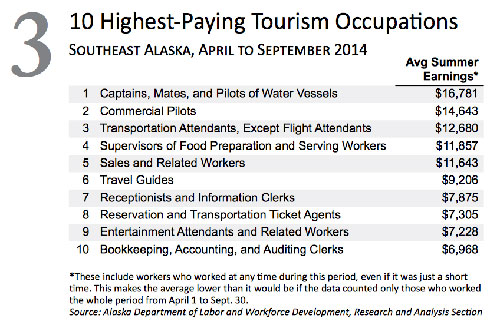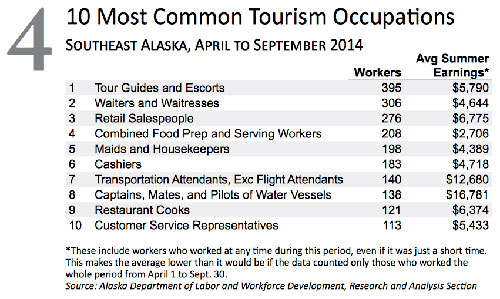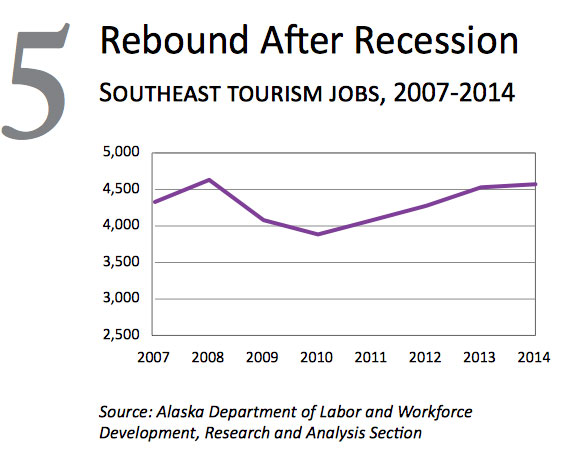
Tourism in Southeast: Visitor-related jobs a key part of the regions's economy
August 06, 2015
Tourism was one of Alaska's first industries, and Southeast was the first visitor destination. During the late 19th century, small numbers of tourists traveled north on steamships, sharing space with miners, fishermen, and aspiring business owners in the new territory. Throughout the next 100 years, the romance of Alaska sank deeper into the American consciousness. Many idealized the ruggedness of Alaska, and it became a point of pride even among Americans who had never seen it. Though many miners returned home empty-handed, stories of Alaska's natural beauty spread further after the Klondike Gold Rush. Naturalists such as John Muir published detailed accounts of the territory. Sitting President Warren G. Harding traveled through Alaska shortly before his death. Hollywood began producing films set in Alaska.
The steamship S.S. Aleutian docks in Juneau sometime between 1939 and 1959. Steamships carried initial visitors to Southeast Alaska, but they were phased out as air travel gained popularity and eventually, cruise ships offered lower-cost trips with more amenities.
Steamships fall from favor Though acclaim for Alaska was widespread, steamships' limited capacity and expense restricted the number of travelers to Southeast. Vacationing by steamship was mostly limited to wealthy travelers, and it lacked the comforts available elsewhere. In 1929, a traveler-class round trip between Seattle and Skagway cost around $90, equivalent to about $1,250 in 2015. The U.S. built the Alaska-Canada Highway during World War II, and though the Alcan increased traffic into Alaska, most of its travelers went farther north to Southcentral or Fairbanks. By the 1960s, streamship travel dwindled with the rise of air travel. The U.S. had a huge stock of aircraft at the end of the war, and it provided subsidies and discounts for emerging airlines to purchase surplus army airplanes. Steamships couldn't compete with the airlines' rates, and sea trips took days rather than hours. Alaska Steamship Company, the last holdout, ended passenger service in 1954. Though Juneau and Annette Island had runways, Alaska's tourist traffic was largely diverted from Southeast. After steamships became archaic, newly formed cruise line companies began to target a broader market. By building giant ships, they could provide trips at a lower cost per customer while expanding onboard amenities, making travel to Alaska accessible to more Americans and returning the focus to Southeast. In the second half of the 20th century, the growing number of visitors to Southeast tracked with the development of more and bigger cruise ships. The first cruise ships sailing the Inside Passage in the late 1960s could carry between 300 and 700 passengers. In 2016, Royal Caribbean's Explorer of the Seas will set a new record in the state with its 3,840-passenger capacity. Tourism vital to Southeast economy The state had 14,056 visitor-related jobs in summer 2014, and though just a third of those were in Southeast, they were a much bigger portion of the region's summer economy at 11 percent versus the statewide 4 percent.
Summer visitors walk through downtown Skagway in front of the cruise ship dock. More than half of Skagway's summer jobs are directly tied to tourism. Photo by Flickr user tommcb05 Southeast's economy is highly seasonal, and most of its additional summer employment is tied to tourism. May through September of 2014 averaged 7,320 more jobs each month than the rest of the year. Of those additional jobs, 4,570 were in visitor-related industries. (See the "About these numbers" sidebar at the botton for how these industries are defined.) Other additional summer employment included seafood processing (1,963 more jobs) and construction (416 more jobs). Most jobs are in Juneau, Ketchikan, and Skagway Southeast's tourism jobs are concentrated in Juneau, Ketchikan, and Skagway at over three-quarters of the region's visitor-related employment in 2014. Juneau had the most at 1,693. (See Exhibit 1.)
Though Skagway has a much smaller number of these jobs, the town's economy is centered on tourism, with total summer employment far exceeding the year-round population. Hundreds of thousands of people visit the small town each summer to see the former mining camp. Fifty-three percent of Skagway's summer jobs are directly visitor-related, and the share is even higher if you include jobs resulting from increased spending by tourism businesses and employees. Another indicator of how significant tourist traffic is to Skagway's economy is its annual sales tax revenue. Skagway's local sales tax of 3 percent, which goes up to 5 percent in the summer, pulled in $7 million in 2013, or $6,996 per year-round resident. Juneau, with a 5 percent sales tax year-round, netted just $1,305 per resident that year. Though Juneau and Ketchikan had more visitor-related jobs overall, their economies are diversified, with tourism jobs representing just 9 and 12 percent of their total summer employment, respectively. Hoonah-Angoon Census Area, which includes Gustavus and Glacier Bay, had the second-highest proportion in Southeast at 26 percent of all summer employment. Petersburg and Wrangell each had a handful of these jobs, and Yakutat had almost no tourism employment in 2014, as defined here, but hosted its first cruise ships this year.
Employees of the Blue Fox Restaurant in Ketchikan pose behind the bar in the early-to-mid 20th century.
The largest chunk of Southeast's tourism jobs, about a third, is in transportation. These include work on everything from whale-watching boats to tour buses and airlines. (See Exhibit 2.) In Skagway, employment in scenic and sightseeing transportation is 432 times more common than in the nation as a whole, largely due to the White Pass and Yukon Route, a refurbished railway originally built during the Gold Rush. The highest-paying occupations are also in transportation. The top-paying job group, which includes captains, mates, and pilots of water vessels, is also one of the most common. (See exhibits 3 and 4.) These 138 workers made an average of $16,781 in summer 2014. Commercial pilots were second at $14,643, and non-flight transportation attendants (who primarily work on whale-watching boats) came in third at $12,680. Almost all seasonal pilots fly small planes, either for flightseeing or passage to rural Alaska.
The next-largest category, at 24 percent, was entertainment and recreation, which encompasses tours and visitor experiences that range from ziplining to wilderness expeditions. The rest were in retail, eating and drinking, and accommodation, each at 14 to 15 percent. These other categories have significantly lower earnings, partly due to more part-time or short-term employment. The most common workers in these categories are tour guides, waiters, and salespeople.
Still bouncing back after recession Visitor-related industries took a major hit nationwide during the 2007-09 national recession. (See Exhibit 5.) While the rest of Alaska's economy fared relatively well, the bleak conditions in the rest of the country stifled travel. U.S. vacation expenditures tanked, and Southeast's visitor-related industries shed more than 500 jobs in summer 2009. Alaska cruise travel dropped by less than a percentage point that year, though visitor expenditures declined more significantly. During summer 2010, cruise ship traffic fell by 15 percent and employers cut another 200 jobs. Visitors and jobs both rebounded in 2011 and have recovered alongside the national economy. Since 2011, the region's visitor-related employment has been rising toward its 2008 high of 4,631, though that figure hasn't yet been reached.
Conner Bell, an Alaska Department of Labor economist in Juneau, specializes in the employment and wages of the Southeast and Southwest economic regions. E-mail Conor. Bell@alaska.gov Material in Alaska Economic Trends is public information, and with appropriate credit may be reproduced without permission. Alaska Economic Trends is provide by the Alaska Department of Labor and Workforce Development.
Edited by Mary Kauffman, SitNews
Source of News:
|
||||
